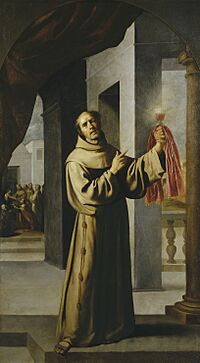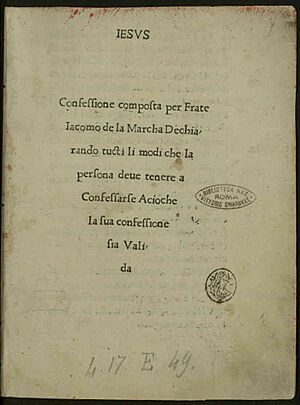James of the Marches facts for kids
Quick facts for kids SaintJames of the Marches |
|
|---|---|

Saint James of the Marches by Francisco Zurbarán
|
|
| Born | c. 1392 Monteprandone, March of Ancona, Papal States |
| Died | 28 November 1476 Naples, Kingdom of Naples |
| Venerated in | Roman Catholicism (Franciscan Order) |
| Beatified | 1624 by Pope Urban VIII |
| Canonized | 1726 by Pope Benedict XIII |
| Major shrine | Sanctuary of St. James of the Marches Monteprandone, Ascoli Piceno, Italy |
| Feast | 28 November |
| Attributes | Depicted holding in his right hand a chalice, out of which a snake is escaping |
| Patronage | Patron of Monteprandone, co-patron of Naples, Italy |
Saint James of the Marches (born Dominic Gangala, around 1391 – November 28, 1476) was an Italian Friar Minor. He was a famous preacher and writer. He also served as a special representative for the Pope and worked as an Inquisitor, investigating people with different religious beliefs.
Contents
Who Was James of the Marches?
James was born as Domenico Gangala in the early 1390s. His family was poor and lived in Monteprandone, a town in central Italy. He started his studies with his uncle, a priest, and later went to school in Ascoli Piceno. He then studied at the University of Perugia, where he earned a degree in law.
After working briefly as a teacher in Florence, he decided to join the Order of Friars Minor. This happened on July 26, 1416, in Assisi. When he joined, he took the new name Jacobus, which is James in English. He studied theology (the study of religious faith) with famous teachers like Bernardine of Siena. James lived a very strict life, fasting often. However, Bernardine told him to be less strict with himself.
James's Life as a Priest and Preacher
James became a priest on June 13, 1420. Soon after, he began traveling and preaching in different parts of Italy. For 50 years, he worked hard, performing many miracles and helping many people change their lives. He also helped spread devotion to the Holy Name of Jesus.
From 1427, James traveled across Europe. He preached in countries like Germany, Austria, Sweden, Denmark, Poland, and Hungary. He encouraged people to live better lives and also worked to address different religious beliefs. He was appointed to investigate groups like the Fraticelli, who had different ideas about how Franciscans should live, especially regarding poverty.
James's Travels and Challenges
From 1432 to 1439, James worked in Bosnia. He faced many challenges there, including opposition from the local rulers, King Tvrtko II and Queen Dorothea. He left Bosnia because of these difficulties.
James also worked to unite different Christian groups. He helped bring together the moderate Hussites (a Christian movement) with the Catholic Church. Later, he worked to reunite the Eastern Orthodox Church with the Catholic Church at a big meeting called the Council of Ferrara-Florence.
He also preached about crusades against the Ottoman Empire. After another famous preacher, John Capistran, died in 1456, James was sent to Hungary to continue his work. He even met with the Danish king, Christian I, to discuss these important matters.
James helped set up "montes pietatis." These were like early banks that lent money at very low interest rates to poor people. He was offered the chance to become a bishop in Milan in 1460, but he said no.
Later Life and Legacy
James was part of the Observant branch of the Friars Minor. This group wanted to bring reforms and changes to the Franciscan Order. He worked hard to encourage these reforms, which sometimes caused disagreements.
In 1455, Pope Callistus III asked James to help settle a disagreement between two groups of Franciscans: the Conventuals and the Observants. His decision, published in 1456, didn't fully please either side.
Later, in 1462, James was involved in a discussion about a religious idea. He had to appeal to the Pope to settle the matter, but no final decision was made. James spent his last three years in Naples and passed away there on November 28, 1476.
James's Writings
James wrote many things during his life. His personal library and some of his original writings are kept in Monteprandone, his hometown.
He wrote a book called "Dialogus contra Fraticellos," which was about the Fraticelli group. He also wrote many sermons, which are religious speeches. One of his writings was about the "Miracles of the Name of Jesus." He also wrote a guide for confessing sins.
Honoring Saint James
James was buried in Naples. In 2001, his body was moved back to Monteprandone, where it is still preserved and can be seen by the public.
He was declared "blessed" (beatified) by Pope Urban VIII in 1624. Later, he was declared a "saint" (canonized) by Pope Benedict XIII in 1726. Naples honors him as one of its patron saints. The Franciscan Order celebrates his feast day on November 28.
You can often see Saint James in pictures holding a chalice (a special cup) with a snake coming out of it. This image reminds us of times when people tried to harm him, or it might refer to a religious discussion he was part of.
Annotations
Sources
 This article incorporates text from a publication now in the public domain: "St. James of the Marches". Catholic Encyclopedia. (1913). New York: Robert Appleton.
This article incorporates text from a publication now in the public domain: "St. James of the Marches". Catholic Encyclopedia. (1913). New York: Robert Appleton.
| Catholic Church titles | ||
|---|---|---|
| Preceded by John of Korčula |
Vicar of Bosnia 1435–1438 |
Succeeded by John of Waya |


